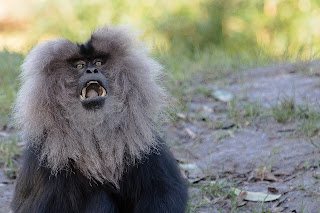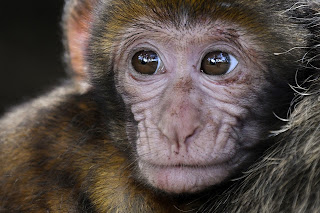 macaque
macaque
The Macaque monkey
The macaque is a monkey that includes more than 20 species worldwide, it is ancient most are from Asia except one it is from North Africa, the macaque lives in the tropical forests of Southeast Asia Is in Sri Lanka and India and in the arid mountains of Pakistan and Afghanistan and the mountains of Japan and northern China and also in Morocco and Nepal and some are suitable for living In the villages they are so smart that they are able to adapt to environments, even some of them are used to living with human beings. It is sacred in India that Hindus live and treat animals as a sacred object.The characteristics of a macaque monkey
The macaque monkey is very strong, it has two arms and legs approximately the same length, and its fur is generally between brown and black, and its mouth is almost the same as the mouth of the dog, and the length of its tail varies with the type of monkey.the length of the males is between 41 to 70 cm and weighs about 5.5 kg, while the females weigh up to 2.4 kg
As for the big ones, like the Tibetan monkey, the female weighs 13 kilograms and the male 18. These monkeys live in forests and plains, or between slopes and rocky terrain, each according to its type.
The macaque is an insatiable beast, in that it has a sack in the cheek that stores additional food. Males are the dominant breed, but they do not always stay with the herd, so it is the females who lead the herds
The reproductive capacity varies according to the species, some of which can grow by 10 to 15% per year if the conditions are appropriate. However, some species that live in the forests are considered endangered animals, and after a year of procreation, the newborn passes from childhood to the juvenile stage where the young begin to bond with their peers by the game, running and various activities, and they mature sexually when they reach the age of 3 to 5 years, and the females remain in the same herd, while the males tend to flock macaques have a lifespan typical Oscillated between 20-30 years
Macaque food
The macaque is mainly herbivorous, but some species also feed on meat such as insects, crabs, and macaques that live in the wild feed on more than a hundred species of plants, including buds, fruits, fresh foliage, bark, roots and flowers, and when the monkey is part of the people, it makes forays into agricultural crops such as wheat, rice, sugar cane and garden crops like tomatoes, bananas, watermelons, manga and papaya, it depends on what people offer them like peanuts, rice, legumes and even cooked foods.Macaque monkey species
- The seven species have a short tail in the Indonesian island of Sulawesi differ in appearance from the distinctive black macaque that lives at the north end of the island, and most types of macaques that live on the island of Sulawesi are threatened of extinction, while for the long-tailed macaque or the so-called crab-eating macaque in Southeast Asia, it has a brown face,
- Rhesus monkeys are native to northern India, Myanmar, southeast Asia and eastern China.
- The Formosa rock macaque is closely related to rhesus monkeys and lives in Taiwan.
- Japanese macaques are the largest and most abundant muscles and have tousled hair, pink faces and short tails covered with fur.
- Lion-tailed macaques, black and gray, with tail-tailed, endangered and found only in a limited area of southern India
- Pigtail macaques, which have a short curved tail on their backs and live in the tropical forests of Southeast Asia, are sometimes trained to pick ripe coconuts.
- The bukkoi monkey is found only on Mentawai Island in Indonesia.
- The truncated-tailed macaque is a powerful monkey with shaggy hair and a pink or red face and a very short tail, living in the woods
- The short-tailed macaque monkey, Father David's macaque, which lives in the mountainous forests of southern China, is generally confused with Stump-tail but is in fact associated with the long-tailed macaque Assam which lives in the foothills of the 'Himalayas and northern Myanmar, and there is also the hooded monkey and tuque macaque from southern India and Sri Lanka respectively and have hair on top of the head growing from its center.
Macaque relationship with humans
The relationship of the macaque with man is an historical and important relationship where a person has helped in many medical and scientific researches, because the antigens in his blood helped the doctors to identify the different types of human blood and these monkeys preceded man in space, and the macaque in general is widely used in medical research In the 1950s, crab-eating macaques were widely used in research that led to the development of the polio vaccine, and these monkeys have played an important role in research on cloning. Initially, scientists cloned the rhesus monkey through a process called nuclear transfer of genetic stem cells in 2001 and 2018. Became for the first Mkak monkey from Alsulton- cloned using a somatic cell transfer process.These monkeys have also been used in particular in neuroscience, in particular in visual perception and the vision system, but approximately 73 to 100% of the macaque monkey carries the virus of the herpes B and this virus is not harmful to him, but if a person is infected, it can cause rare and dangerous infections which can lead to death. It is advisable not to take the macaque as a pet, and in Vietnam, the maca is eaten by some people.



















0 comments: